
Surgeons may be adding years to the lives of their patients in operation theatres, but their own bodies may often be paying a high price for this. Long hours of laparoscopic surgery -where the eyes stay fixed on the monitor while the hands work through long, rigid instruments -often force surgeons into strained, non-neutral postures. Shoulders are hunched, wrists twist unnaturally and the upper body remains in non-neutral postures, leading to fatigue, pain and, in many cases, long-term musculoskeletal injuries. To address this silent occupational hazard, IIT Delhi and AIIMS have joined forces to redesign laparoscopic tools with improved ergonomics.Pain and numbness in the fingers, wrists, shoulders and neck due to the design and use of current laparoscopic instruments is a major occupational concern. These physical challenges – combined with the high surgical volumes in Indian hospitals – often result in chronic injuries, prolonged recovery periods and loss of work hours. “In the early years of surgery, the focus was on patient safety. Then came environmental concerns – like reducing surgical waste and carbon footprint. But now, we must also make surgery safe for the surgeons themselves,” said Dr. Sachit Anand, paediatric surgeon at AIIMS. “We are working with tools that are 300mm long, performing complex procedures without tactile feedback. The stress on our muscles, joints and posture is immense, yet it isn’t often talked about.”Prof Sabyasachi Paldas of IIT-D explained that the nature of work in laparoscopic surgery differed significantly from open or robotic procedures. “The surgeons face limited range of motion, the fulcrum effect in tool use, loss of tactile feedback and camera orientation issues. These lead to awkward hand positions and repetitive movements. Over time, this contributes to musculoskeletal disorders,” Paldas said.
To tackle these challenges, IIT-D and AIIMS are co-developing a new generation of laparoscopic tools using a multi-stage, research-informed, participatory design approach. The team comprises industrial design faculty and students from IIT, among them Nabeeha Akhtar, bachelor of design student, and practising surgeons from AIIMS to ensure the redesigned tools address real-world needs. “Our focus is to reduce fatigue and pain by minimising non-neutral postures and repetitive hand motions,” said Dr. Gourab Kar, assistant professor, design department, IIT-D. “We’re also looking at redesigning the surgical environment itself – such as table height and monitor position – to reduce stress on the body.”
Prototypes of new ergonomic instruments such as graspers, scissors and needle holders are being developed. The aim is to have working models ready by Dec, with simulation studies scheduled for Jan next year. Feedback from these studies will guide refinements, leading toward commercialisation.
“In laparoscopy, you’re working in 2D but aiming for 3D outcomes. Movements made outside the body must translate to delicate actions inside, amplifying stress on the surgeon’s wrists, fingers, shoulders and spine,” added Anand. “We’re dealing with high patient volumes and low ergonomic awareness. This redesign is long overdue.”

